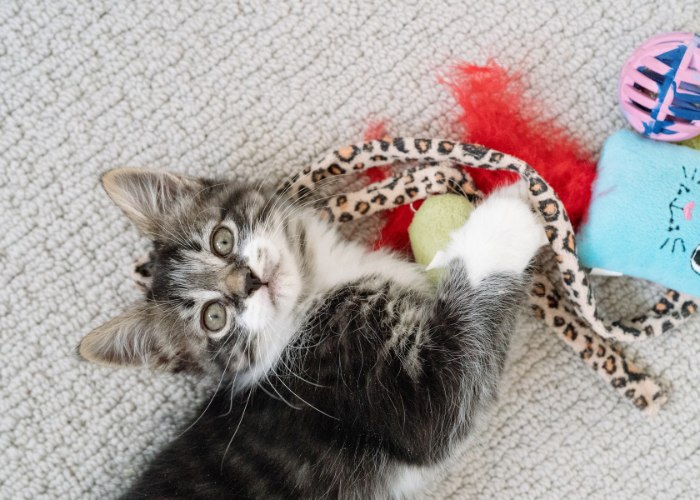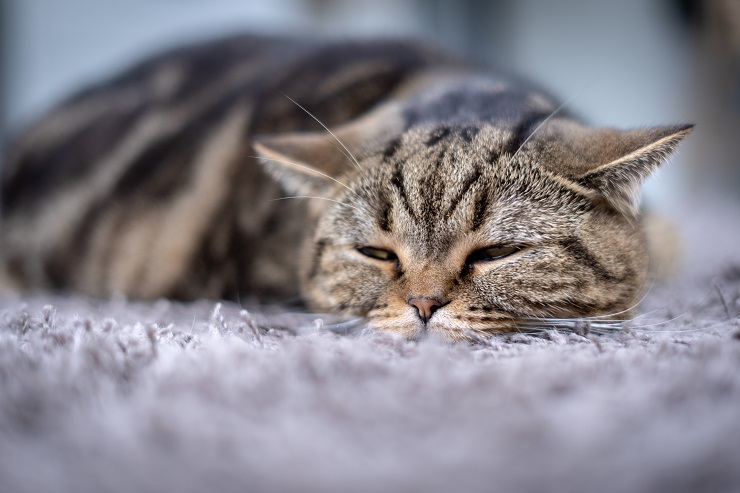
Plastic bags, food wrappers, crinkle toys–all these objects are likely to pique your cat’s interest. Cats like to hit them with their paws, bat them down the hallway, wrestle with them, and your living room lion might even try to shred a crinkly item with their teeth and claws.
Out of all the toys and random objects in your house, the crinkly ones seem to be the best in the eyes of your cat. Have you ever wondered why?
We obviously can’t know for certain without hearing the reasoning right from a cat’s mouth, but we can make several assumptions based on what we know about feline behavior and biology.
1. It’s a Different and Interesting Sound
Cats can hear mice squeaking under your floorboards, small birds chittering up a tree, and so many other high-pitched sounds that most human ears can’t sense. From the triangle shape of the outer ear to the anatomy of the inner ear, feline ears are specially designed to pick up high frequencies that human ears have no chance of detecting.
Also Read: Do Cats Have Good Hearing?
When your cat gets excited over those enticing crinkling sounds, it’s likely because they hear so much more than the basic rustling that you hear. The sound of someone balling up a plastic bag is so much fuller and more interesting than we realize.
Cats are intrigued by that rustling because it sounds completely different than most other household noises. It’s like how a person might follow the sound of good music to satisfy their curiosity or how toddlers are attracted to the toys that make the most noise.
2. It’s an Instinctually Comforting Sound
Cats have been domestic pets for at least 10,000 years, but they still haven’t abandoned all of their wild instincts. Even the most pampered pets still possess basic survival instincts including how to hunt, find water, and protect themselves. We can see many of those wild instincts in their normal, everyday behavior, and a cat’s attraction to crinkly things might be connected to their wild roots.
Your cat might prefer the comfiest pillows and the coziest blankets in the house, but there’s at least part of them that still craves the feeling of being outdoors.
Even if your cat has never put a paw in the woods, animal experts believe they’re instinctively attracted to sights, smells, and sounds reminiscent of hunting in the wild. The sound of a crinkly piece of plastic is similar to the sound of leaves crunching underfoot. It’s believed these sounds offer both comfort and excitement while appealing to your cat’s inner wild side.
3. It’s a Conditioned Response

If you regularly buy cat treats that come in a plastic bag, or any other container that makes noise, your cat will quickly learn to recognize that sound.
Besides being the sound of hunting prey in the woods, a crinkly food wrapper might also be the sound of an impending cat treat. Cats have good memories.
If you regularly buy cat treats that come in a plastic bag, or any other container that makes noise, your cat will quickly learn to recognize that sound. They could be snoozing in a different room, but as soon as they hear the treat bag, they’ll come running. As a result, anything that sounds similar to that treat bag is likely to catch their attention.
This same concept applies to toys and playtime. A lot of cat toys are designed to make crinkly noises. Once your cat learns the sounds of a favorite toy, their ears will be specifically attuned to detect that noise and anything that sounds similar.
Cats learn to relate crinkle sounds to the things they like best, including treats and playtime. Your cat also can’t tell the difference between a discarded plastic bag and a store-bought toy. They both make crinkle noises, and therefore, they’re both loads of fun.
4. It Gets Your Attention
We wouldn’t say cats are master manipulators, but they’re observant enough to learn a few tricks. Cats know that meowing will get you to look at them, and making crinkling sounds can accomplish the same goal.
When you hear the crinkling of paper coming from the office, you’re likely to look for your cat to see what trouble they’re getting into. Or, maybe, you just want to witness some kind of cute behavior. Either way, the sound both alerts you and lures you to your cat’s location. It won’t take long for your cat to realize that making sounds is an effective strategy to get a person’s attention.
5. Some Crinkly Materials Have the Opposite Effect
It’s clear that most cats enjoy the sound of a crinkly plastic bag or toy, but observational evidence also tells us that some similar sounds are actually cat deterrents. The sound that tin foil makes when you move it around is an example.
This isn’t true for all cats, but many cats seem to actively avoid tin foil once they realize what sound it makes. This is likely because tin foil has the potential to make sounds that are so high pitched that they’re undetectable to human ears and extremely irritating to cat ears.
Some people have successfully trained cats to stay off counters and away from Christmas trees by temporarily covering the areas with tin foil. The tin foil turns out to be so bothersome to the cats that they gladly keep their distance.
6. Some Sounds Cause Seizures

As tempting as it is to try out all crinkly objects to see how your cat reacts, a study from 2015 offers a warning to cat owners.
As tempting as it is to try out all crinkly objects to see how your cat reacts, a study from 2015 offers a warning to cat owners. Research revealed certain sounds can trigger seizures in cats.
The condition is called Feline Audiogenic Reflex Seizures (FARS) and while not common, it seems to affect older cats most often. It’s unclear what specifically causes FARS, but everyday household sounds including the tapping of glass, hammering a nail, a metal spool hitting a ceramic bowl, and the sound of tin foil and plastic are identified as seizure triggers.
Cats with a confirmed diagnosis of FARS can be treated with medication. If your cat has regular and seemingly random seizures, talk to your veterinarian about the possibility of FARS.






